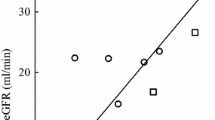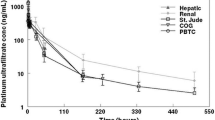Abstract.
An obese 53-year-old woman (height 167 cm, weight 130 kg) with metastatic breast cancer received high-dose chemotherapy comprising cyclophosphamide, thiotepa and carboplatin (CTC). The cyclophosphamide (1 g/m2 per day) and thiotepa (80 mg/m2 per day) doses were based on body surface area (BSA) calculated using total body weight (TBW). The daily carboplatin dose was calculated based on the Calvert formula, using a target area under the plasma concentration-time curve (AUC) value of 3.25 mg·min/ml and applying the Cockcroft-Gault equation to estimate the glomerular filtration rate. The patient received the three agents as short infusions over four consecutive days. For therapeutic drug monitoring (TDM), blood samples were collected on day 1. Thiotepa and its main metabolite tepa, ultrafilterable platinum, cyclophosphamide and its activated metabolite 4-hydroxycyclophosphamide were determined. Individual pharmacokinetics were assessed using Bayesian analysis. Exposure to the individual compounds was determined by calculating the AUC. Exposures to 4-hydroxycyclophosphamide, the combination of thiotepa/tepa and carboplatin were 94%, 117% and 71% higher than the median respective exposures in a non-obese population of patients (n=24) receiving similar doses. Because high AUCs of 4-hydroxycyclophosphamide, thiotepa/tepa and carboplatin correlate with increased toxicity, the treatment risk in this obese patient was significantly increased. Therefore doses were adapted on the 3rd day of the course. It is concluded that cyclophosphamide and thiotepa in obese patients should not be dosed on the basis of BSA incorporating TBW since the patient will be overexposed. Moreover, applying the Cockcroft-Gault equation to obese patients leads to an overprediction of creatinine clearance and, when used in the Calvert equation, consequently to a carboplatin dose that is too high. Obese patients represent a unique group of patients in which TDM is extremely valuable in optimizing dosing, particularly in high-dose chemotherapy.
Similar content being viewed by others
Author information
Authors and Affiliations
Additional information
Electronic Publication
Rights and permissions
About this article
Cite this article
de Jonge, M.E., Mathôt, R.A., van Dam, S.M. et al. Extremely high exposures in an obese patient receiving high-dose cyclophosphamide, thiotepa and carboplatin. Cancer Chemother Pharmacol 50, 251–255 (2002). https://doi.org/10.1007/s00280-002-0494-7
Received:
Accepted:
Issue Date:
DOI: https://doi.org/10.1007/s00280-002-0494-7




